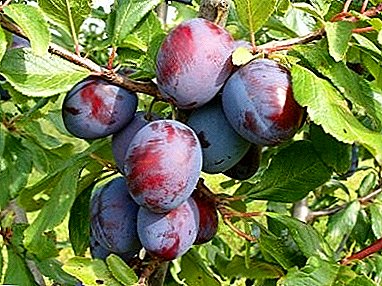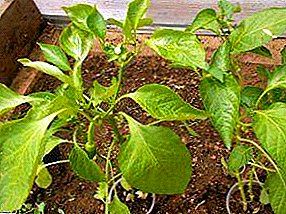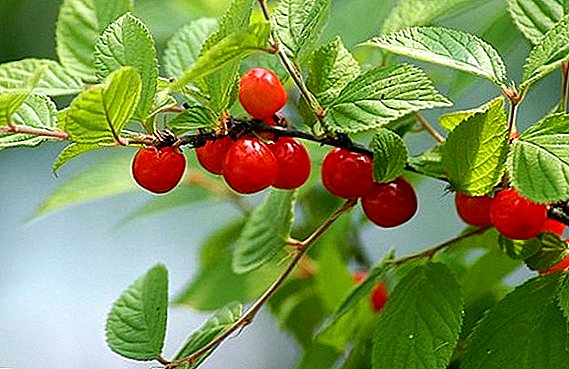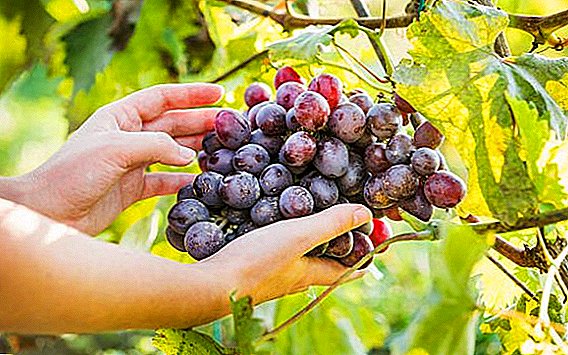 Grapes - this is a very tasty berry that grows in clusters on a climbing vine. These berries are among the first that people cultivated. The benefits of grapes were known in ancient times. Now it is used not only in cooking, but also in medicine and in cosmetology. Consider what is so useful grapes.
Grapes - this is a very tasty berry that grows in clusters on a climbing vine. These berries are among the first that people cultivated. The benefits of grapes were known in ancient times. Now it is used not only in cooking, but also in medicine and in cosmetology. Consider what is so useful grapes.
Calorie and chemical composition
Considered fruits have a very rich composition. Different enzymes, pectins, vitamins, acids, sugars, fiber make them healthy.
Nutritional value per 100 g of product:
- proteins - 0.5 g;
- carbohydrates - 10-15 g;
- sugar - 15-18 g;
- water - 80.5 g;
- dietary fiber - 1.6 g;
- ash - 0.5 g;
- unsaturated fatty acids - 0.2 g;
- mono - and disaccharides - 15 g;
- saturated fatty acids - 0.3 g

Vitamins that make up grapes:
- vitamin A - 0.1 g;
- Vitamin B1 - 0.05 g;
- Vitamin B2 - 0.02 g;
- Vitamin B5 - 0.18 g;
- Vitamin B6 - 0.7 g;
- Vitamin B9 - 4 micrograms;
- vitamin C - 6 mcg;
- Vitamin PP - 0.3 mg;
- Vitamin E - 0.4 mg.
Of the macronutrients in the berries contain:
- magnesium - 17 mg;
- calcium - 30 mg;
- sodium - 26 mg;
- phosphorus - 22 mg;
- potassium - 225 mg;
- chlorine - 1 mg;
- sulfur - 7 mg.
 From trace elements:
From trace elements:
- zinc - 0.091 mg;
- iodine - 8 mcg;
- iron 0.6 mg;
- copper - 80 mcg;
- fluorine - 12 mcg;
- manganese - 0.09 mcg;
- cobalt - 2 mcg;
- molybdenum - 3 µg;
- silicon - 12 mcg;
- aluminum - 380 mcg.
Calorie grapes depends on the variety. 100 g of product contains:
- 43 kcal - in white grapes;
- 65 kcal - in sour varieties;
- 64 kcal - in red grapes;
- 95 kcal - in the raisin;
- 240 kcal - in dried raisin.

The benefits of grapes for the body
The composition of the fruit makes them very useful for humans. Grape berries:
- strengthen teeth, bones;
- normalize the work of the heart;
- prevent the formation of stones and sand in the kidneys;
- free the body from toxins and heavy metals;
- give energy and vigor;
- are a preventive measure against many ailments;
- improve the digestive tract;
- help with problems with the respiratory system;
- have a calming effect on the nervous system;
- improve blood formation;
- are antioxidant.
Did you know? In antiquity, vintage was considered a very dangerous occupation and people had to write a will before work. The fact is that the support for long grape branches were trees growing nearby. But over time, they dried up, and the berries had to be plucked from their tops, where the twigs are very thin, which often led to fatal accidents.
Women
Grape berries have a positive effect on the female body. They contain plant pigments that prevent the development of malignant tumors in the genitals and breasts.  In addition, grapes:
In addition, grapes:
- normalizes the menstrual cycle;
- increases libido;
- relieves irritability;
- eliminates the disadvantages of skin rashes and normalizes hormones;
- promotes skin rejuvenation;
- restores damaged hair on the head, and also prevents their loss.
Men
For men, this berry is no less useful. She is capable restore and maintain potencyand also to improve the work of the urogenital system. With a constant consumption of berries for three months, the quantity and quality of spermatozoa increases significantly.
Athletes grapes helps to relieve muscle fatigue and build muscle mass.
Read also about the beneficial and harmful properties of grape seed.
Is it possible
Although grapes have a lot of useful properties, some of them need to be used with caution.
Pregnant
The fruits in question contain many vitamins, therefore they are very useful for pregnant women. It is recommended to eat them in first trimesters of pregnancy.  Calcium, which is part of grapes, contributes to the proper formation of fetal bones, and folic acid is useful for the normal course of pregnancy. However, in the later stages, doctors do not advise eating grapes, as it has a high calorie content. The baby will quickly gain weight, which will complicate the process of childbirth. Experts also warn that the skin of the berries litters the intestines, and the juice causes fermentation in it - this is not very useful for the future mom.
Calcium, which is part of grapes, contributes to the proper formation of fetal bones, and folic acid is useful for the normal course of pregnancy. However, in the later stages, doctors do not advise eating grapes, as it has a high calorie content. The baby will quickly gain weight, which will complicate the process of childbirth. Experts also warn that the skin of the berries litters the intestines, and the juice causes fermentation in it - this is not very useful for the future mom.
Important! Pregnant women are recommended to buy grapes in the season of their ripening. Fruits purchased in winter or spring are likely to contain chemicals for better preservation, and their use can lead to poisoning.
Nursing mothers
Eat grapes during breastfeeding need very careful, as with breast milk everything eaten by mommy comes to the baby. Fruits cause strong fermentation, and this leads to pain in the tummy of the infant. Starting to enter into the diet of a nursing woman grapes is recommended when the child reaches 3-4 months. On the day you need to eat 1-2 berries and monitor the reaction of the baby. If there are no negative reactions, then you can continue to gradually introduce a new product into the diet. And if there is an allergy, the berries are immediately excluded from the nursing menu. 
Losing weight
If you competently eat the product in question, it will help you quickly throw off those extra pounds. Berries have a lot of calories, so after they are consumed a person has a long feeling of fullness. This product is often included in diets, as it contains a hormone that promotes burning, fat deposition and elimination of toxins. The main thing is to follow all the rules of the diet, and then the extra weight will go away.
With diabetes
With this disease it is recommended to reduce the consumption of products containing a lot of sugar in the composition. These products include grapes. It has a lot of glucose and other sugars, because of this berries are very high in calories.
Grapes in diabetes have long been banned. But scientists have recently made a discovery - with the help of berries, you can fight disease, but they should only be red varieties. Studies have shown that juicy and sweet fruits help to fight syndromes that provoke ailment. They treat and are prophylactic. Eat grapes should be in reasonable quantities and only after consultation with the doctor. 
When gastritis or pancreatitis
Considered berries It is forbidden to use during gastritis, because even the sweetest varieties contain a lot of acid - this negatively affects the irritated mucous membrane of the stomach. Grapes also increase acidity. Having eaten only a bunch, a person can aggravate the disease, causing pain, discomfort, heartburn, nausea.
It is allowed to use the fruit during gastritis, if the acidity of the stomach is low, and there are no ulcers or erosions on the mucosa.
A person with a diagnosis "pancreatitis" grapes are not recommended for some reason.:
- the high content of acids in the berries harms the work of enzymes and causes pancreatic irritation;
- Fiber helps to remove accumulated substances in the body, and this can increase diarrhea and flatulence, which is often found in people with pancreatitis;
- Grapes - sweet berry containing glucose and sugar. Therefore, it is poorly tolerated in this disease.
Important! In acute pancreatitis and in the period of exacerbation, the berry under consideration intensifies the inflammatory process and causes severe pain. Therefore, it should be completely excluded from the diet.
From what age can children
Children are recommended to start producing grapes from 2 years old, and only if there is no allergy.  Berries can bring many benefits to a small body:
Berries can bring many benefits to a small body:
- they have a general health effect;
- protect against respiratory diseases;
- positively affect the functioning of the liver and blood formation process;
- improve appetite;
- neutralize the effects of nervous overstrain;
- restore the spent strength after exercise.
Find out what are useful and in what form can you eat fruits and berries: apples, pears, quince, plums, cherry plums, peach, apricot, nectarine, lemon, orange, mandarin, cherry, cherry, raspberries, strawberries, gooseberries, currants (red, white, black), lingonberry, cranberry.
Tips on drinking
Consider how and when it is better to use grapes, as well as the recommended amount per day and with which the berries are combined.
Green, red or dark: which one is better
The highest content of nutrients in black grape. The dark color of the berries due to the large accumulation of anthocyanin - a phenolic compound, which is a strong antioxidant and has anti-inflammatory effect. This element prevents the vessels from oxidizing, slows down the aging of the brain and the growth of unhealthy cells.
Second place green berries. They also contain a mass of healing elements, including resveratrol. This substance has antifungal action, inhibits oxidative processes and prevents Alzheimer's disease.  In third place is the green seedless grapes, or raisin. This variety is artificially bred, it contains a lot of sugars. The concentration of nutrients in it is 50% less than in black berries. Nevertheless, many people like it very much because it is convenient to dry this variety.
In third place is the green seedless grapes, or raisin. This variety is artificially bred, it contains a lot of sugars. The concentration of nutrients in it is 50% less than in black berries. Nevertheless, many people like it very much because it is convenient to dry this variety.
Read also about the best varieties and agronomic cultivation of grapes souring.
Breakfast, lunch or dinner
Grapes contain a lot of calories, so it’s best to eat in the morning. In the evening you can eat berries 2 hours before bedtime. Fruits have a diuretic effect, and also cause fermentation in the body. Therefore, if you eat them before a night rest, it can interfere with the peaceful flow of sleep.
How much can you eat per day
In the considered fruits there are a lot of vitamins and useful elements. But they can not be abused. Modern nutritionists recommend eating 200 g fresh berries in a day. If you do not go beyond these limits, you can be sure that you will not cause harm to your body.
What can be done and what is combined
From grapes you can make excellent preparations for the winter: wine, juices, compotes, jam, jam. Berries can be pickled or raisins. In cooking, fruits are used to decorate appetizers and desserts. They are also added to fruit salads, baked biscuits and muffins with raisins.
We advise you to read about the beneficial properties and homemade raisins - dried grapes.
Eat grapes most often as an independent dessert. Berries are well combined with low-fat cheeses, with dietary meat. From the vine leaves you can cook a classic Caucasian dish - dolma.  Grapes do not combine with:
Grapes do not combine with:
- raw vegetables;
- other fruits;
- milk;
- carbonated drinks;
- greasy food;
- alcohol.
Learn the secrets of home winemaking.
Top 10 best wine grapes
There are a lot of grapes for making wine.
Did you know? The largest bottle of wine in the world has a height of 1.8 m, while together with the contents it weighs 585 kg.
Consider the 10 best:
- Aligote This grape variety is medium, round, light green with a thin skin. The taste of the berries is pleasant, sweet, gentle.
- Riesling. Clusters of grapes are very dense. The fruits are green, round and juicy. The variety is frost resistant, therefore suitable for cultivation in any climate. It is high-yielding (up to 100 centners per hectare).
- Chardonnay. This variety has small greenish-white berries. It is characterized by average yield (70 centners per hectare), prone to fungal diseases, and during the rainy season it suffers from gray rot.
- Muscat is white. Aroma at a grade pleasant. The berries are fleshy, greenish, with thick skin. Bushes are hypersensitive to frost, so in cold climates they need to be sheltered for the winter.
- Rkatsiteli. The variety is characterized by high yield. Tassels hang on branches for a long time. The berries are light green, almost transparent, rounded, with an original flavor.
- Traminer pink (Tramin). Clusters of this variety are dense. Fruits are light pink, have a gray patina. Their skin is strong. The berries are juicy. Tramin is characterized by low productivity (up to 60 centners per hectare), frost resistance.
- Cabernet Sauvignon. Cylindrical brushes. The berries are small, dark, juicy, have a slight taste of grass and nightshade. The variety is high-yielding (up to 100 centners per hectare). It is resistant to frost and grape diseases.
- Pinot Noir. The grape has a dense brush. Its berries are blue-black or purple. Juice is colorless. The variety is resistant to cold and disease.
- Merlot Noir. The variety is characterized by cylindrical loose brushes. The berries are spherical, blue-black. Their skin is of medium thickness, the flesh is juicy. Shrubs are resistant to oidium, but vulnerable to gray rot. Frost tolerates poorly. Yield from medium to high, depending on the climate.
- Saperavi. The berries are medium, oval, dark blue with a thick waxy coating. The skin is thin, but dense. The flesh is juicy. The variety is not resistant to oidium. In rainy weather it is affected by gray mold.










Tips for beginner growers: spring care - planting seedlings, inoculation, pruning, spraying against diseases, fertilizing; transplanting, summer pruning, pasynkovanie, care during flowering, pest control; Autumn care - pruning, transplanting.
Contraindications and harm
Grapes have not only useful properties. In some cases, it can cause harm to the body:
- It is recommended to remove berries from the menu to people who have stomach ailments, hyperacidity, ulcers;
- it is better to refuse grapes with diabetes, as the fruits contain a lot of sugars;
- patients with diarrhea and predisposition to flatulence are better not to eat the fruits in question, otherwise the condition may worsen;
- it is better not to eat grapes after eating another meal - it will be difficult for the stomach to digest it;
- grape juice can worsen teeth. To avoid caries, it is necessary to rinse the mouth with clean water after drinking grapes;
- it is better not to eat berries for people with renal insufficiency due to the high content of potassium in it;
- fruits should not be used together with drugs for blood clotting, such as "phenacetin", "warfarin".
Grapes are not a means of all diseases. But he can improve the general condition of the body. Berries have much more beneficial properties than harmful ones. They heal, strengthen, tone up. The main thing is to eat the fruits correctly, to remember about contraindications, not to abuse them - and then they will definitely benefit.












